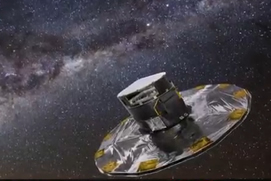Spanish company Crisa, a division of the Astrium group, has built the electronics which will manage the giant focal plane of the Gaia satellite. This satellite is the star project of the European Space Agency (ESA).
The mission of Gaia—which was successfully launched last week from the spaceport in Kourou, French Guiana—is to construct an unprecedented map of our galaxy. During its expected five year lifetime the satellite will observe one billion celestial bodies individually about 70 times. These repeated observations will be used to create a dynamic, three-dimensional map containing information about the mass, speed and brightness of each body. Gaia will not only take images of the Milky Way, but will also help astronomers to study its origin and the evolution of our galaxy.
To carry out this task the satellite is equipped with two telescopes and a camera with a focal plane that has a resolution of almost one gigapixel. Gaia’s resolution is so great that, from the Earth, it could measure the thumb of an astronaut standing on the Moon. This digital camera is the largest that’s ever been built for a space mission and, what’s more, it uses Spanish technology.
Crisa has provided 106 proximity electronics modules, one for each of the satellite’s optical sensors which are called Charged Couple Devices (CCDs). These modules are responsible for sequencing, polarizing, conditioning, digitalizing and transmitting the images taken by each sensor. CCDs represent an advanced version of the sensors used by conventional digital cameras. Crisa’s technology allows the camera to gather data selectively, in order to transmit information that is relevant for the stars being studied (approximately one out of every ten).
The University of Barcelona (Universitat de Barcelona) will play a key role in analyzing the huge quantity of data that Gaia will provide during its five years of operation. In addition, some of the critical components of the satellite, such as the enormous 10 meter diameter sunshield to protect it from being overheated by the Sun, were also made in Spain. Sener was the contractor for the sunshield, while Nuter provided some of its high precision components and CTA performed pre-launch vibration testing.
